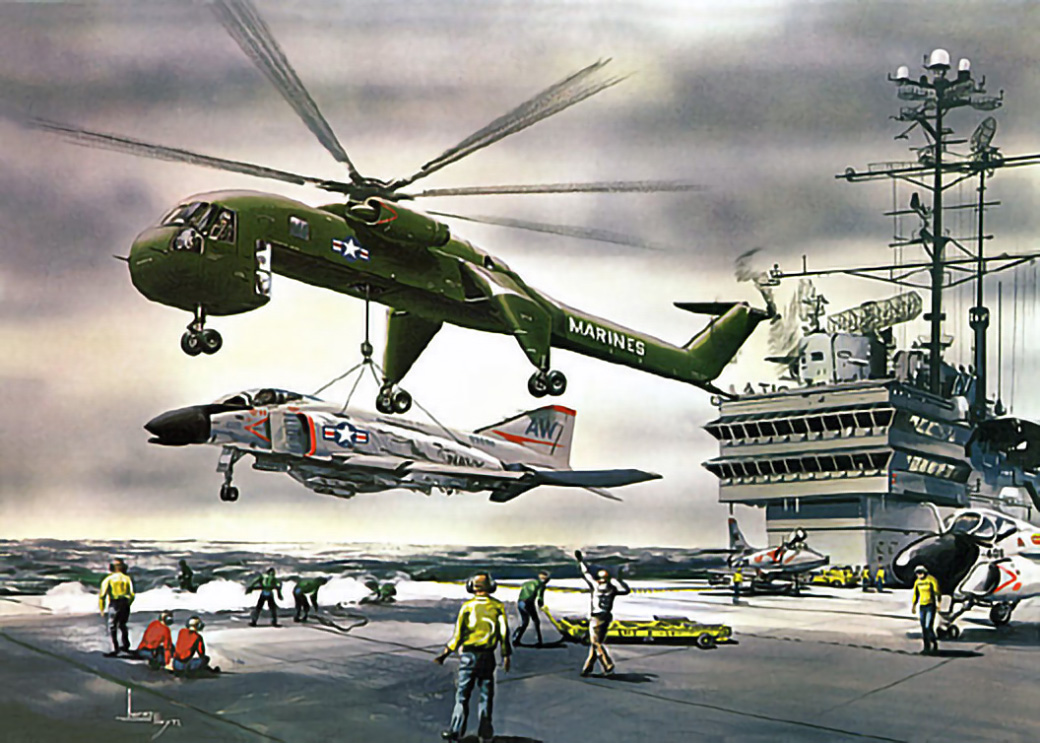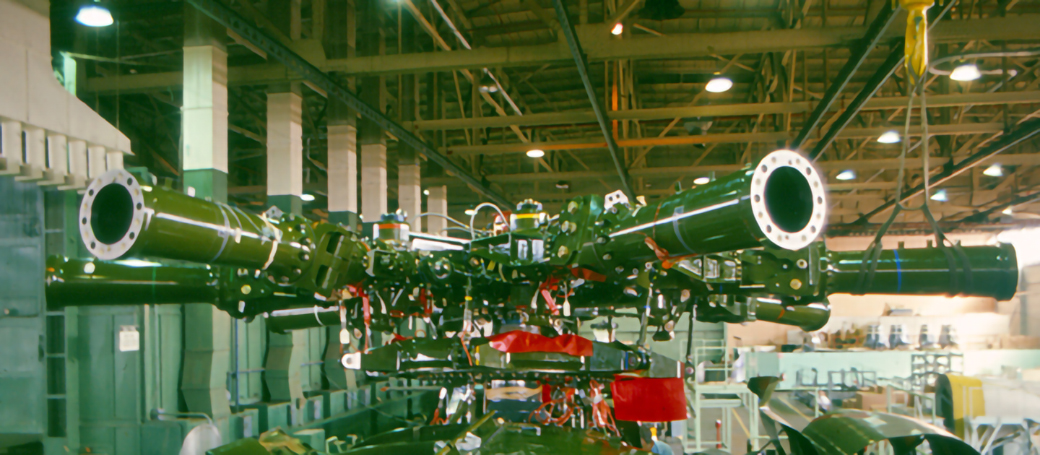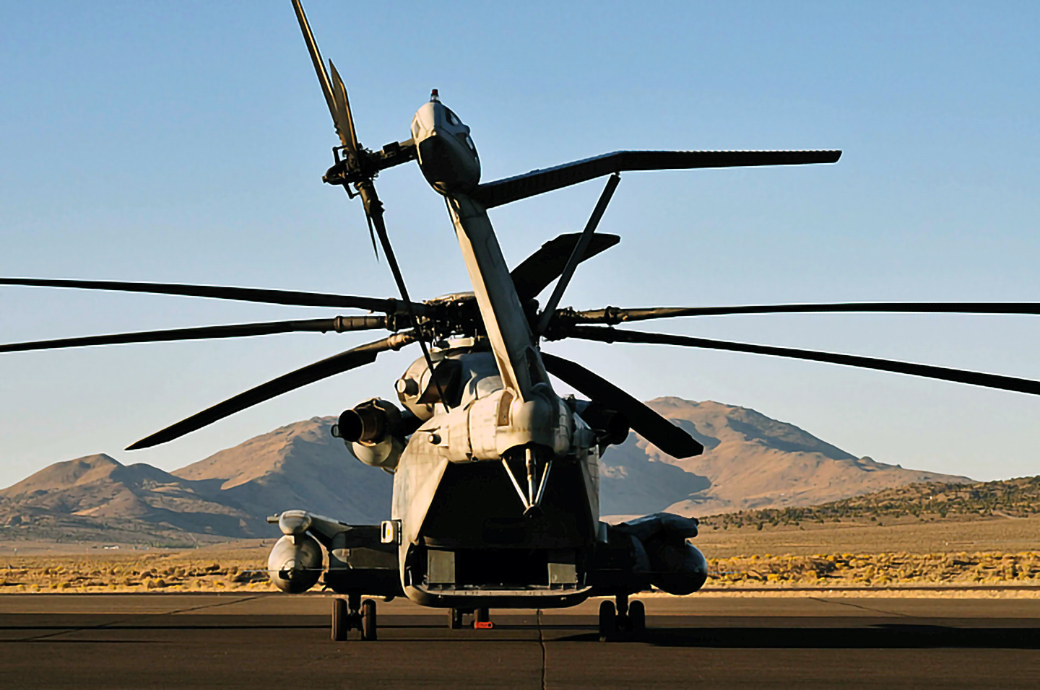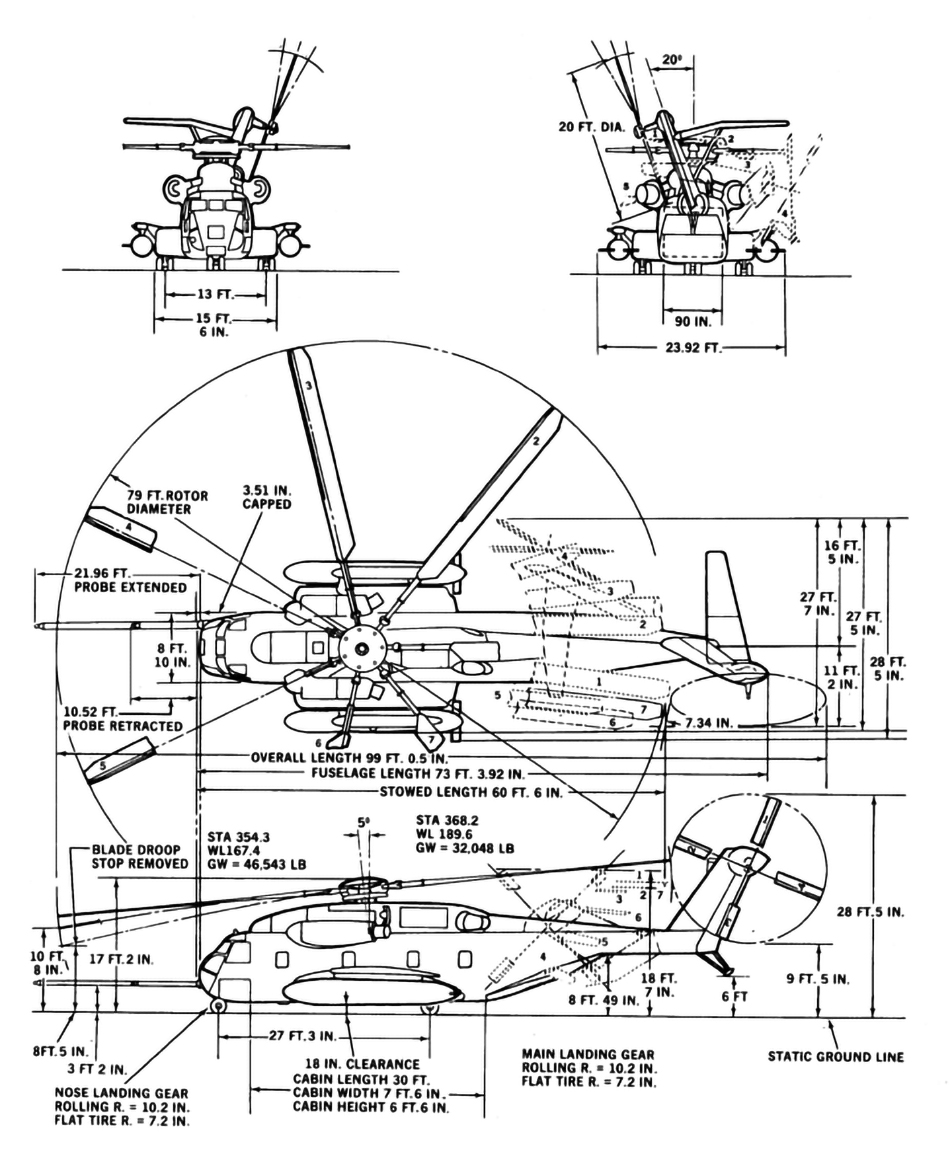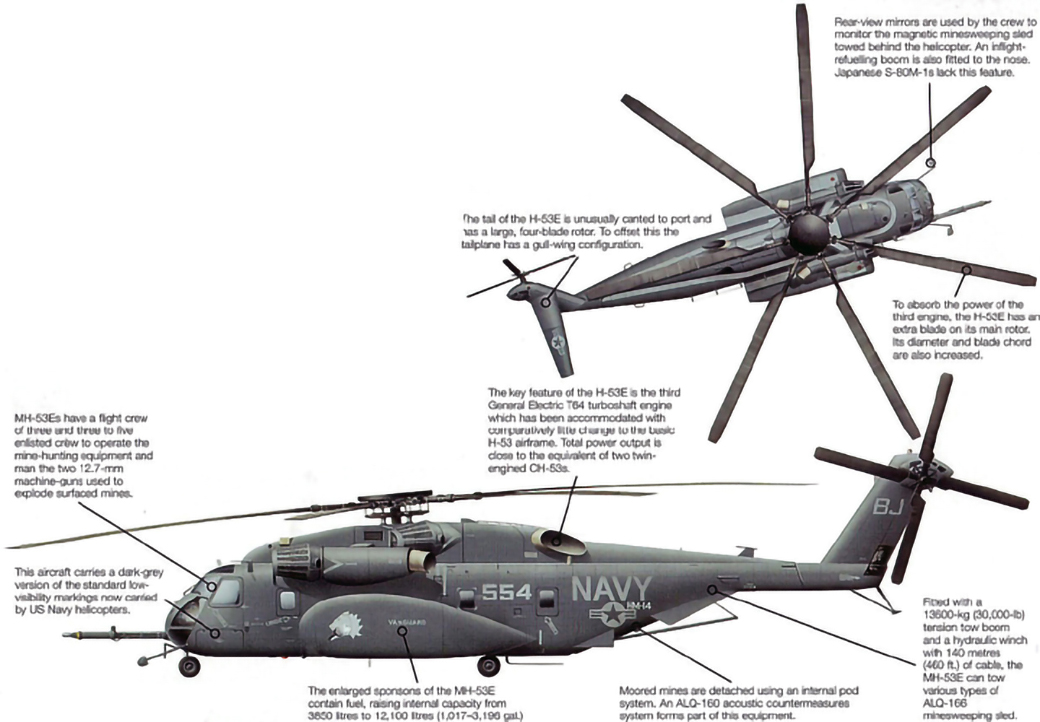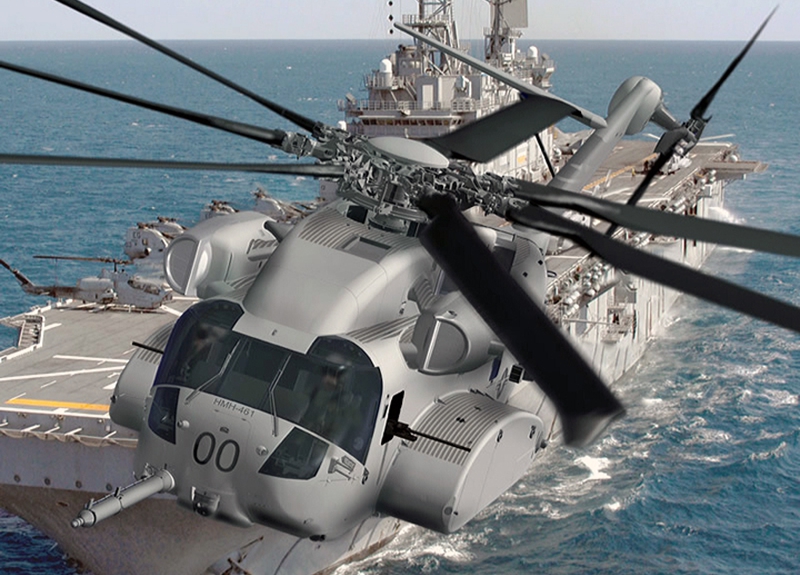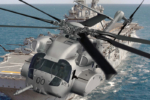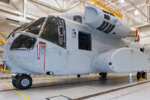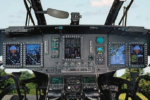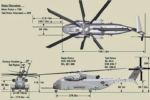Sikorsky Product History
Sikorsky S-65
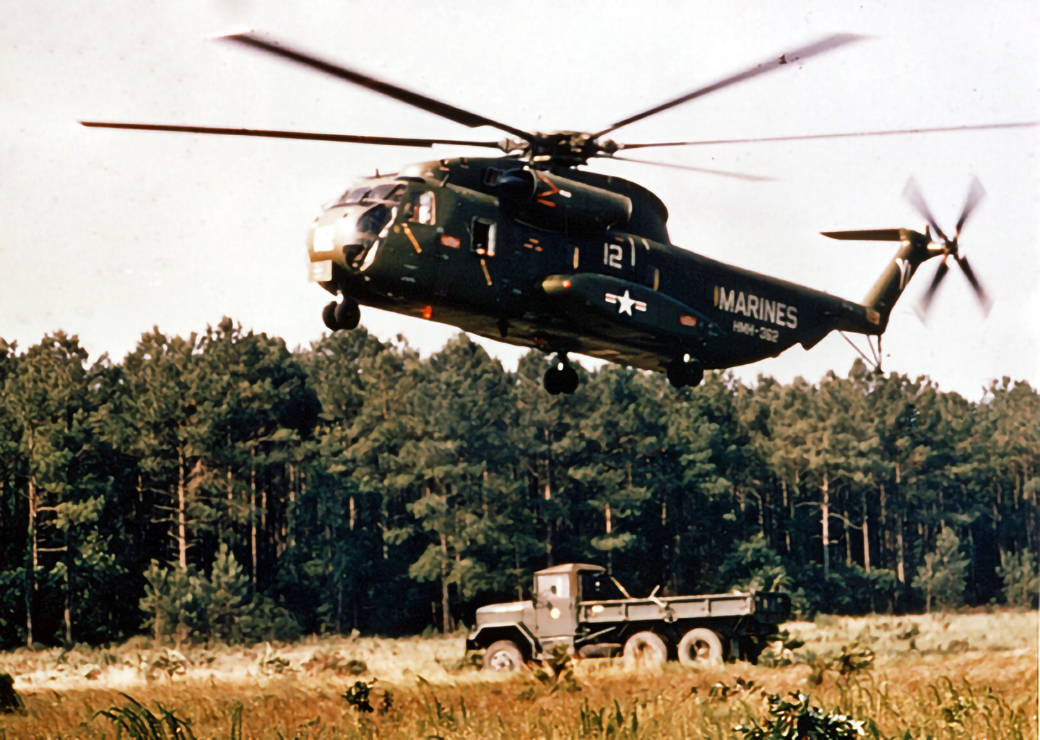
Background
In January 1961, The Department of Defense issued a Request for Proposals for the Tri-Service Assault Transport Program, a medium sized Vertical Take Off and Landing (VTOL) aircraft. This project was initiated to provide a replacement forSikorsky S-56 (HR2S-1) helicopter and the competition was won by the Ling Tempco Vought (LTV) XC-142A VTOL Transport. The Marine Corps was concerned with the XC-142A prop-rotor downwash which was considerably higher than the HR2S-1 (S-56), decided it was unsuitable for shipboard operations, and decided to make their own request for a new heavy lift helicopter.
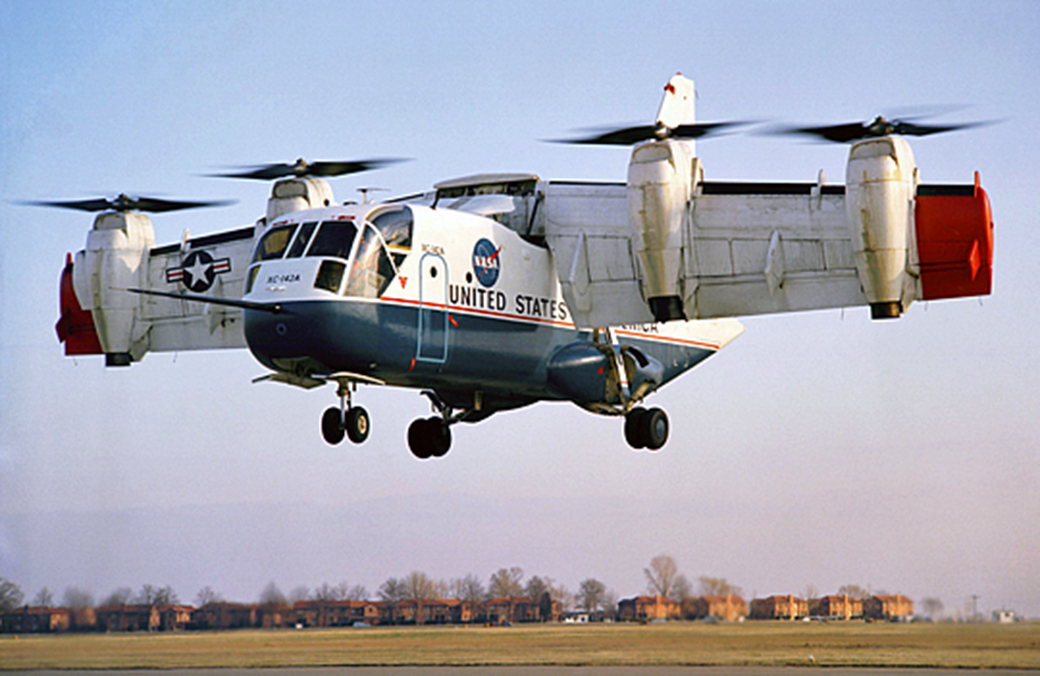
On March 7, 1962, the Bureau of Naval Weapons (BuWeps) issued a Request for Proposals for a ship based helicopter able to lift an 8,000 pounds (3630 kg) payload over a radius of 100 nm (115 miles, 185 km) at a speed of 150 knots (172 mph, 278 km/h). Its mission was ship-to-shore transport, downed aircraft recovery, personnel transport, and Medical Evacuation. Three proposals were submitted to BuWeps: Vertol proposed a version of the HC-1B (CH-47A Chinook), Kaman proposed a development of the British-designed Fairey Rotodyne, and Sikorsky proposed the S-65. In July 1962 Sikorsky was chosen as a result of technical, production capability, and cost considerations. However, insufficient funds prevented a contract award. Sikorsky negotiated to lower theResearch and Development (R&D) costs and reduce the number of prototype helicopters to two instead of the original four prototype helicopters. On September24, 1962Sikorsky was awarded a contract to design and develop a mock up, a static test airframe, and two YCH-53A prototype helicopters for $9,965,635. First flight of the YCH-53A occurred on October 14, 1964
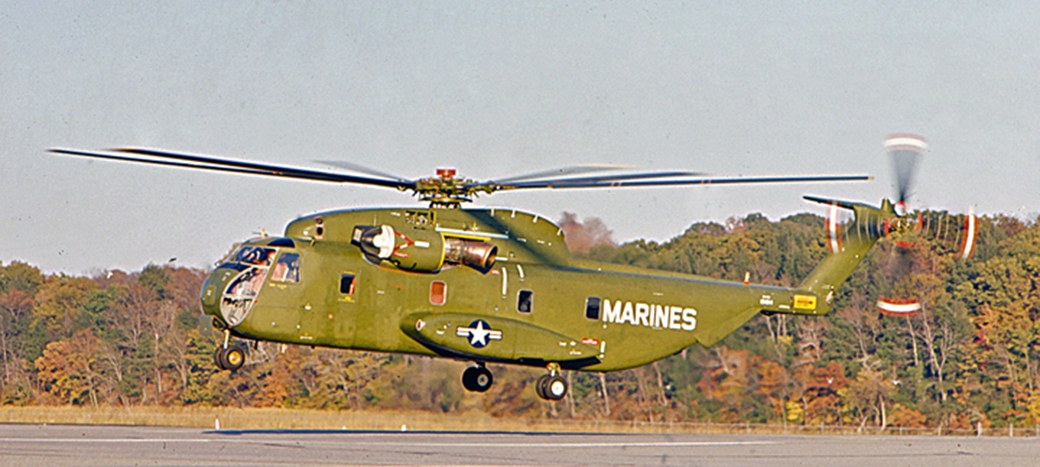
The S-65 helicopters featured a 72 foot 6 bladed fully articulated main rotor and a 4 bladed tail rotor powered by two 2,850 shp General ElectricT-64-6 free turbine turboshaft engines. All fuel was carried in external sponsons. With a crew of 3,it was capable of carrying 38 fully-equipped troops or 24 litter patients and 4 medical attendants. Internally 8,000 pounds of cargo could be carried or 13,000 pounds externally.
The S-65 helicopter design was based on previous designs. The S-56 and S-64 models contributed the basis for dynamic components and the S-61R provided a basic shape for the S-65
In January 1965,a MarineCH-53A flew at speeds as high as 170 knots (196 mph) at gross weights of up to 35,000 lbs. making it the free world’s fastest production helicopter.
S-65 Model Designations
| Customer | Model No. | Nickname | Mission |
|---|---|---|---|
| Two Engine Models | |||
| US Marine Corps | CH-53A/D | Sea Stallion | Utility Transport |
| US Navy | RH-53A/D | Sea Stallion | Airborne Minesweeping |
| US Air Force | HH-53B/C | Super Jolly Green Giant | Combat Search and Rescue |
| US Air Force | CH-53C | General Transport Work | |
| US Air Force | HH/MH-53H/J/M | Pave Low I,II,III,IV | CSAR with low light TV |
| German Army/Air Force | CH-53G/GS/GE/GA | License built CH-53D | Utility Transport |
| Israeli Air Force | S-65C-3 | Yas’ur/ Yas’ur 2000/ Yas’ur 2025 | Utility Transport |
| Three Engine Model | |||
| US Marine Corps | CH-53E | Super Stallion | Heavy Lift Transport |
| US Navy | MH-53E | Sea Dragon | Airborne Minesweeping |
S-65 Development Timeline
Contract Award
First Flight
First Flight "Over the Fence"
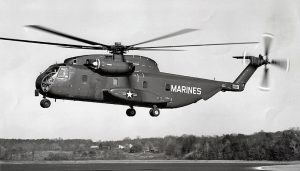
Introduced to Public
Start of Flight Test Trials
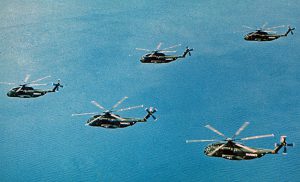
First Delivery
First Delivery to U.S. Air Force
First HH-53C Delivery
Demonstration to U.S. Marines
First CH-53D Delivery
First German CH-53G Delivery
First Israeli S-65C-3 Delivery
First Trans-Pacific Helicopter Flight
CH-53E Development Approval
First RH-53D Delivery
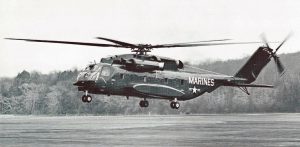
First Flight of YCH-53E
CH-53E Production Authrorized
First Flight of CH-53E
CH-53E Flight Test Trials Begin
CH-53E Production Contract Signed
First CH-53E Delivery
Delivery to HMH-465
Configuration Features of S-65 Two Engine Models
CH-53A
U.S Marine Corps heavy lift helicopter featured a six blade 72 foot main rotor and a 4 bladed 16 foot anti torque tail rotor. The fuselage was watertight allowing water landings in an emergency.
RH-53A
Fifteen CH-53A helicopters modified for the U. S. Navy airborne minesweeping mission.
HH-53B
U.S. Air Force modelbased on the CH-53A helicopter modified for the Combat Search and Rescue (CSAR) mission. Air-to-Air Refueling capability and jettisonable external auxiliary fuel tanks, a rescue hoist above the crew door were added. The engines were upgraded to T64-GE-3 engines (3,080 shp).
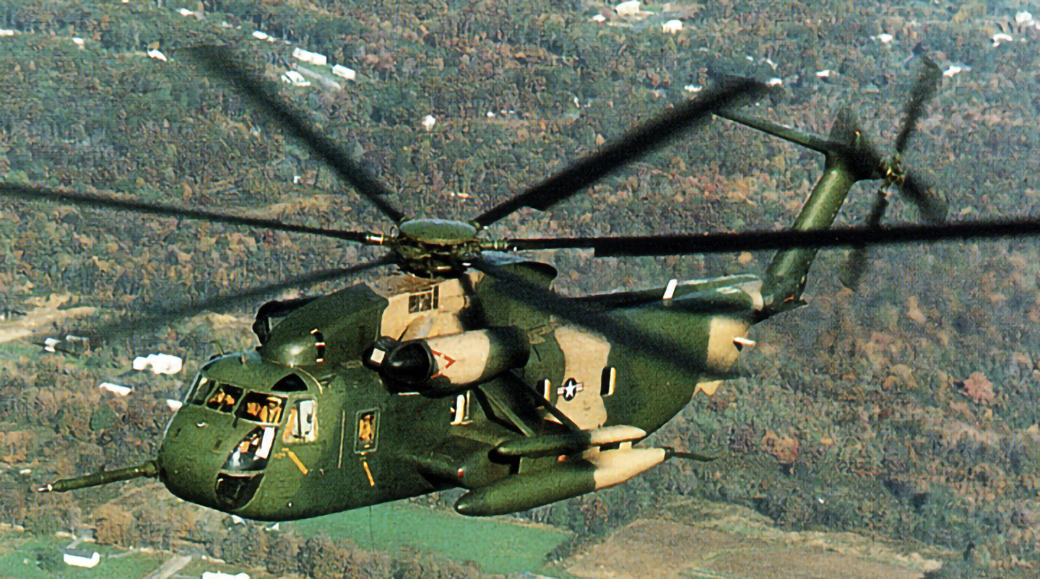
HH-53C
U.S. Air Force follow-on to the HH-53B CSAR helicopters with increased engine power (T64-GE-7 engines 3,435 shp).and cantilevered external auxiliary fuel tank mounts.
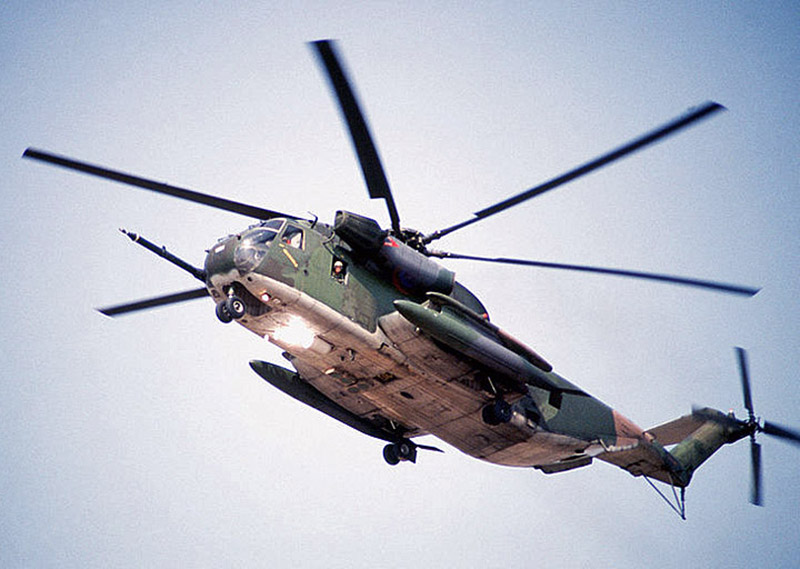
CH-53D
A follow-on to the CH-53A for the Marines with many improvements including more powerful engines (T64-GE-412 engines 3,925 shp) with Engine Air Particle Separators (EAPS) which eliminated ingestion of dust and foreign objects and an uprated transmission.Internal cargo carrying ability was increased to 14,000 pounds for 200 nautical miles. The CH-53D was retired by the Marines in February 2012 after completing 43 years of service andtheir final deploymentssupporting Operation Enduring Freedom in Afghanistan.
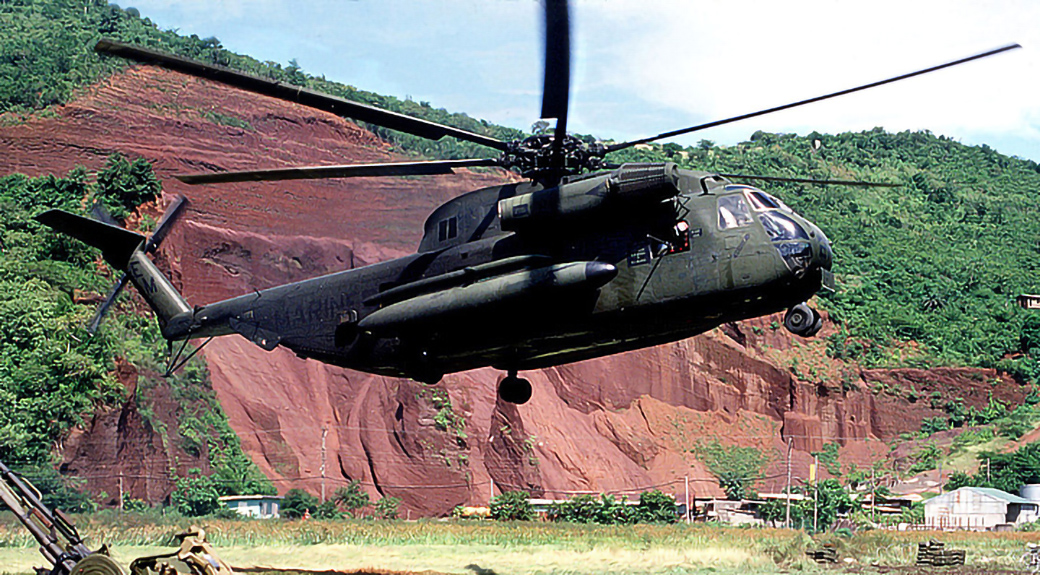
RH-53D
36 U.S. Navy Minesweeping helicopters ( 6 sold to Iran by U.S Government as a Foreign Military Sale (FMS)). The RH-53D helicopters featured an improved fully redundant four axis (pitch, roll, yaw, collective) AFCS (Automatic Flight Control System), larger external fuel tanks, and specialized AMCM equipment. The AMCM equipment included a tow boom attached under the main gearbox, adjustable rear view mirrors on the nose , tow tension and cable angle instruments in the cockpit. Guard rails were installed on the rear ramp to prevent the tow cable from contacting the airframe. Internal winches deployed the tow cable and a fuel system allowed the power units on the towed sled to be refueled under tow. The RH-53D was capable of flying with 15,000 pounds of cable tension while towing at 15 knots.
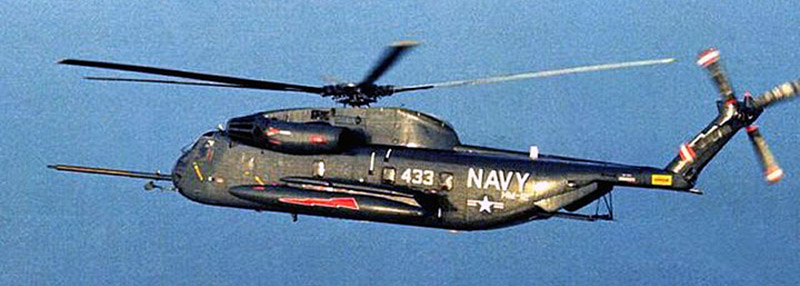
S-65C-1 (CH-53G/GS/GE/GA)
CH-53D helicopters builtin a Co-Production Program for the German Army(Heersflieger) by VFW/Fokker in Speyer, Germany. The German Government has modernized the fleet of helicopters over the years and they remain in service 44 years, as of 2013, after the first delivery. The latest upgrade to the CH-53GA configuration equips the helicopters for an operational lifetime lasting beyond 2030. In January 2013, all CH-53 helicopters were transferred from the German Army (Heersflieger) to the German Air Force (Luftwaffe).
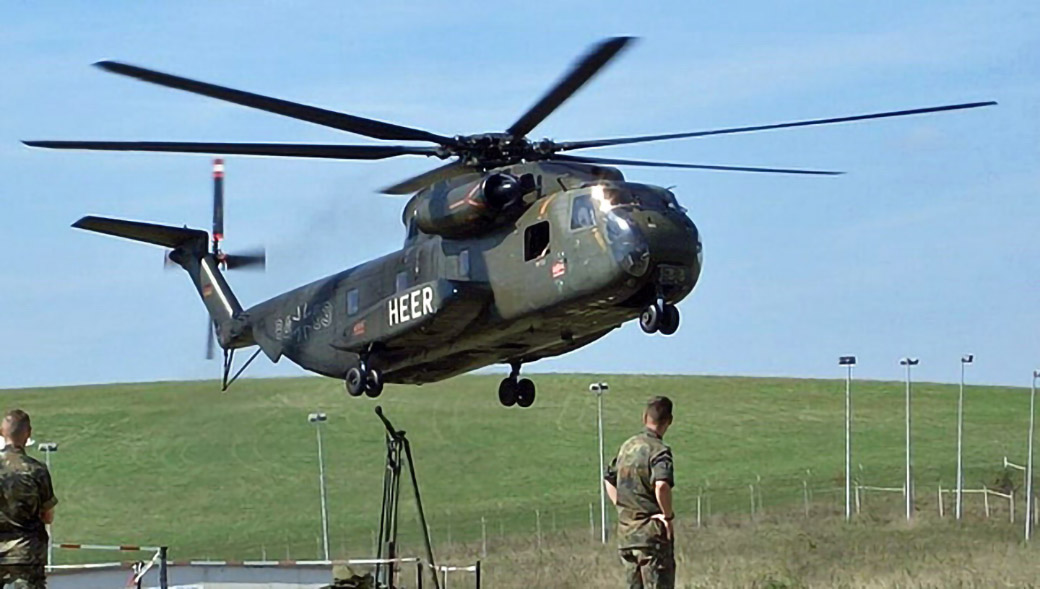
S-65C-2
Two S-65C-2 (CH-53D) helicopters were delivered to Austria. Although they performed well in high altitude operations, high operating costs eventually lead to the sale of the 2 helicopters to Israel.
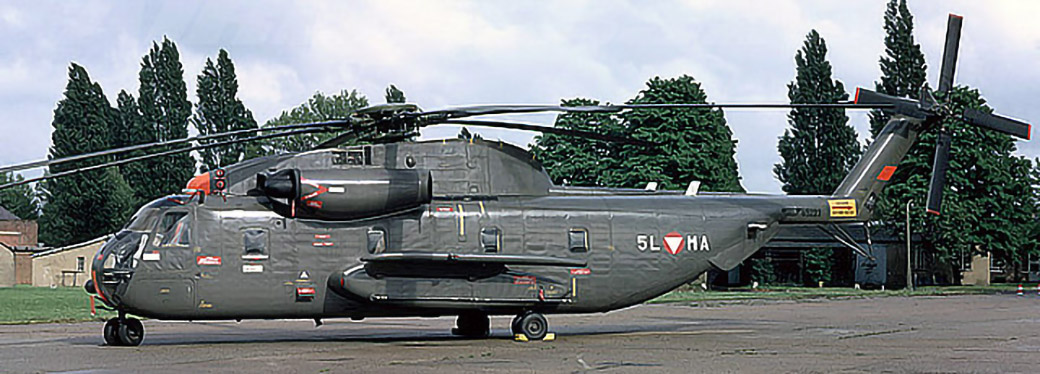
S-65C-3 CH-53 Yasur (Petrel)
Forty two CH-53D helicopters sold to the Government of Israel. Israel also acquired additional used H-53 helicopters from Austria and the U.S. Government. They have been upgraded several times and are projected to remain in service until at least 2025.
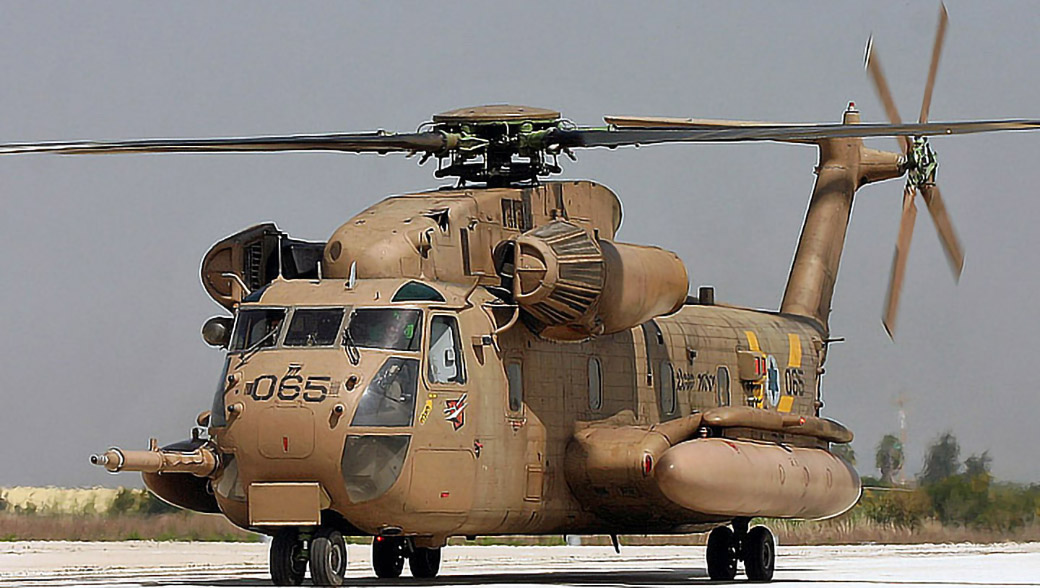
VH-53F
Six VH-53F helicopters were ordered for the Presidential support program. Trial landings at the White House revealed that the downwash from the H-53 rotor system was not compatible with the White House shrubbery. The plan was cancelled by the White House groundskeeper. Two CH-53D helicopters modified with Glossy “Marine Green” paint and more comfortable interiorswere assigned to VX-1 as VH-53D helicopters to carry the press corps and spare parts in support of the Executive Transport mission.
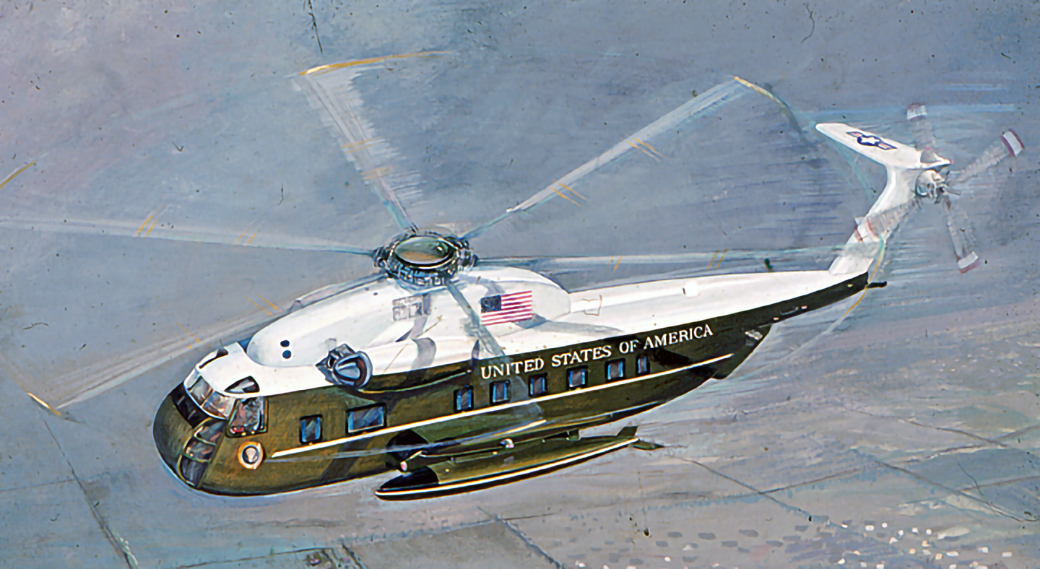
MH-53H/J/M
U.S. Air Force Special Operations helicopters with sophisticated equipment for the CSAR and Special Forces insertion and extraction. They were retired in October 2008 after final service in Iraq.
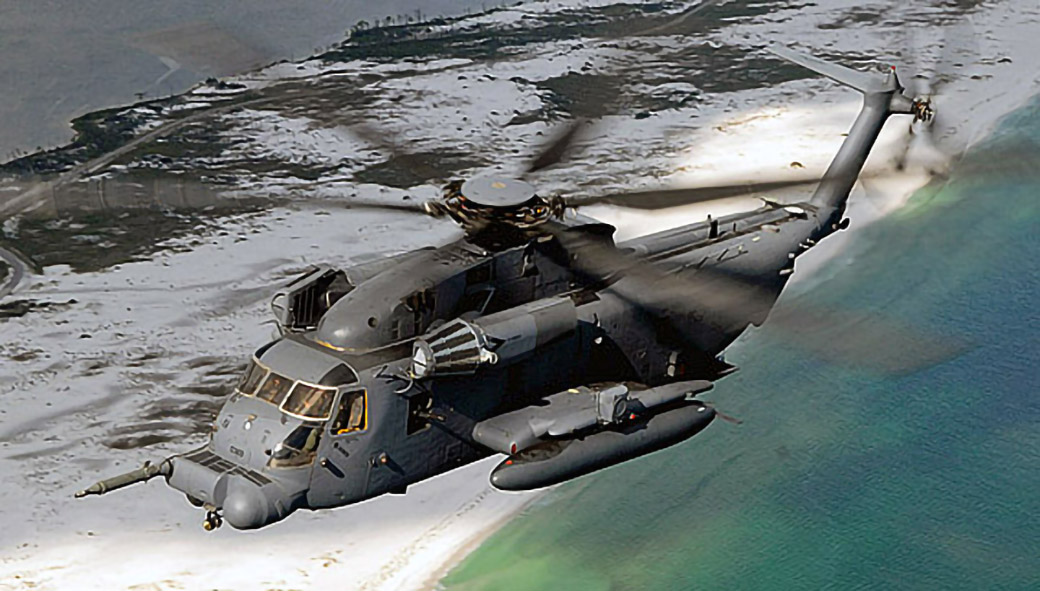
Design Features
The CH-53A helicopters featured extensive use of Titanium which at the time was considered an exotic metal with limited applications.
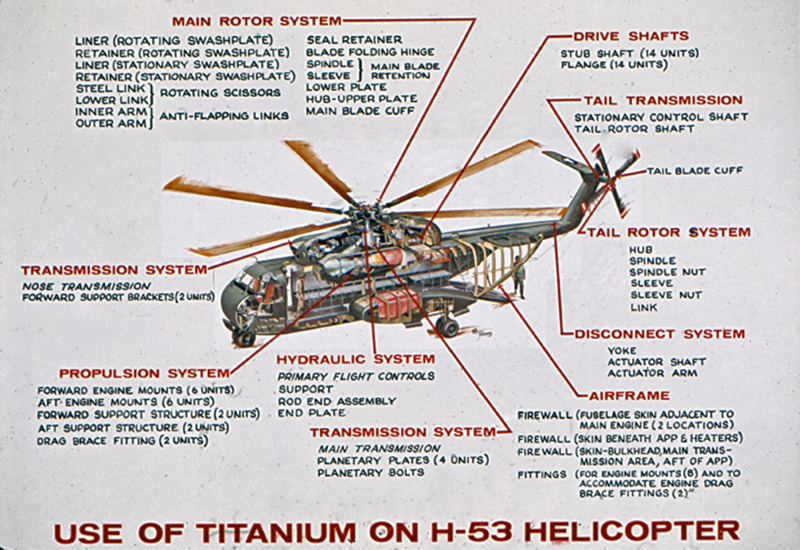
The S-65 fuselage was constructed of an aluminum structure with aluminum skins and composite removable panels. The sharp break in the fuselage for the rear ramp caused significant drag. The engineering solution to this problem was to add strakes, known as “Elephant Ears”, to the fuselage at the ramp.
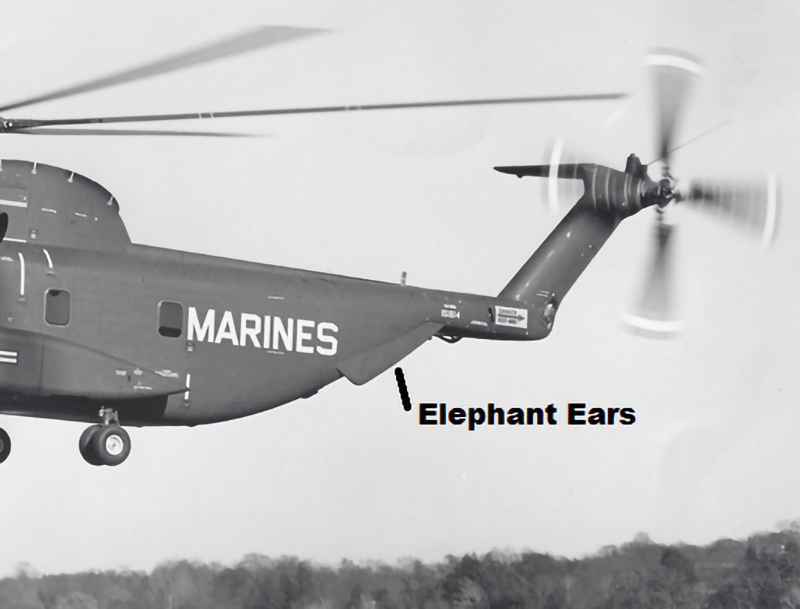
Stabilizer. The fixed stabilizer was located on top of the tail rotor pylon on the right side. This 24.5 sq. ft. stabilizer had 10 degrees of dihedral and a zero degree angle of incidence.
Main Rotor Assemblies
Oil Lubricated. A 6 bladed fully articulated oil lubricated main rotor head was installed on the S-65 helicopter. The 72 foot 2.7 inch diameter main rotor was controlled by a 2 stage hydraulicirreversible servo control system.
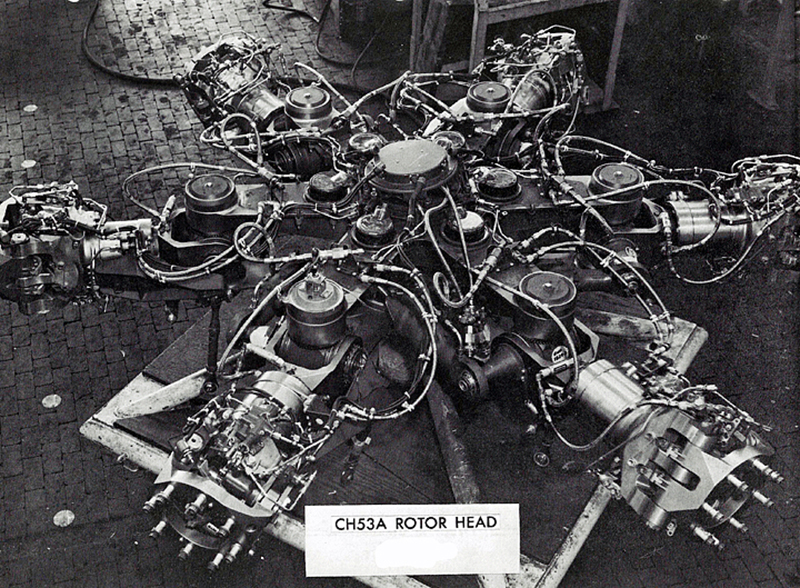
Elastomeric Bearings. A Government funded design program was initiated to greatly reduce maintenance of the main rotor head while increasing reliability. All lubrication requirements were eliminated to solve a persistent oil leakage problem The elastomeric head went through extensive bench and whirl stand testing and achieved first flight in early 1972. A retrofit program for the CH-53D fleet replaced the oil lubricated main rotor with a lower maintenance elastomeric rotor head. It featured a cone-shaped spherical bearing for pitch, flap, lead and lag changes. The elastomeric bearing was constructed of a sandwich of rubber and metal laminates with no lubrication required.
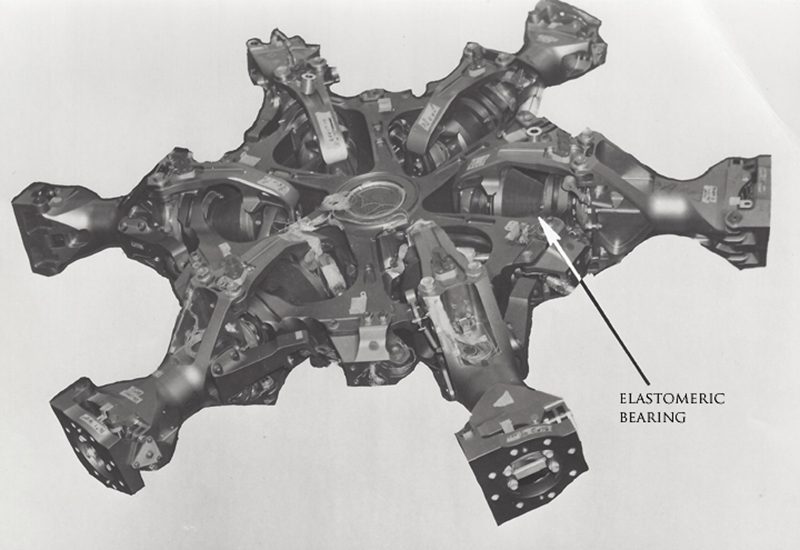
Main Rotor Blades (Aluminum Spar). The all metal main rotor blades were constructed of aluminum alloy except for titanium cuffs. The main rotor blade was constructed of a hollow extruded aluminum spar pressurized with nitrogen (Blade Inspection System(BIM)) to detect cracks withhoneycomb filled, aluminum skinned pockets bonded to the spar. A cockpit warning system advised the flight crew if spar pressure was depleted.The H-53 fleet was retrofitted by the U.S. Government with the IBIS (Inflight Blade Inspection System) which used radioactive Strontium 90 to detect a loss of pressure in the blade spar. A detector assembly picked up the radiation signal which sent a signal to a signal processor. The signal processor picked up the message which illuminated the caution lights in the cockpit.
Improved Main Rotor Blades (Titanium Spar). In May ,1970 Sikorsky initiated a company funded Research and Development (R&D) project prior to receiving Government funding to increase the CH-53D helicopter lift and performance with a titanium spar main rotor blade identified as the Improved Rotor Blade (IRB). Titanium was the metal of choice due to its strength and light weight. In order to economically produce the 33 foot titanium spars new manufacturing techniques were developed. The spars were constructed of a long and narrow sheet of titanium. The sheets were cold formed in a four step process using a 40 foot long 2,000 ton hydraulic press into a round shape with the gap closed by plasma arc welding. The titanium root attachment was inertially bonded to the end of the spar. The assembly was then placed in heated dies and creep formed into the final oval shape. The Nomex honeycomb pockets were bonded to the spar and the entire assembly wrapped in fiberglass epoxy to produce the complete blade. . The IRB, with a larger chord, improved SC1095 airfoils and a higher 16 degree twist, allowed a gross weight increase from 36,693 to 42,000 pounds. The first flight of a CH-53D with the IRB installed was September 29, 1971. The same blades were used on the CH/MH-53E helicopter with 3 foot extenders to increase the main rotor diameter. Blades of similar construction were used for both the S-70 and S-76 model helicopters.
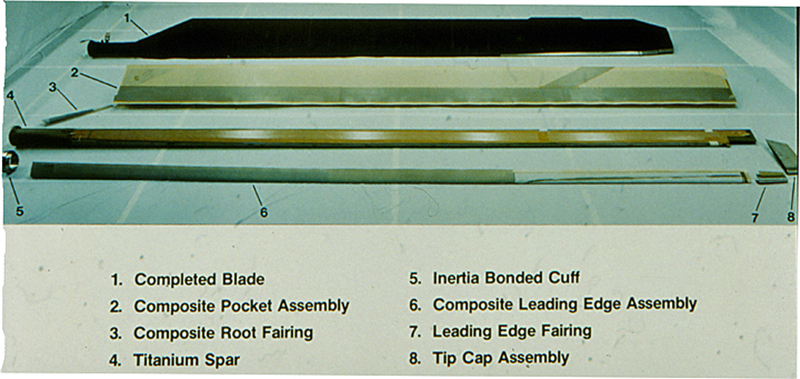
Cruise Guide Indicators. The cruise guide indicators, one for the pilot and one for the copilot were mounted on the instrument panel to assist the pilot in obtaining optimum performance from the helicopter by providing a direct indication of the degree of main rotor blade stall.. This was accomplished by a transducer mounted within the piston of the aft lateral main rotor servo which measured the vibratory loads imposed on the stationary swashplate. Thevibratory loads on the stationary swashplate were influenced by varying conditions of main rotor speed, gross weight, altitude, temperature, load factor, airspeed, andcenter-of-gravity position. These loads were a direct indication of the onset of blade stall or the degree of blade stall encountered during a flight.The indicators were graduated in percent, from 0 to 100 percent. Normal operation was between 0 and 30 percent with a maximum of 70 percent. Transient operations between 30 and 70 percent were permitted. If one indicator failed, the other indicator would read double.
Transmission System. The transmission system consists of two nose gearboxes, a main gearbox, accessory gearbox, intermediate gearbox and the tail rotor gearbox.
Nose Gearbox. The nose gearbox rotates the output of the engine 135 degrees to align with the main gearbox inputs and reduces engine rpm from 13,600 rpm to 6,023 rpm through high speed bevel gears
Main Gearbox. The main gearbox couples the two nose gearboxes and provides output power for the main rotor, tail rotor, and accessory gearboxes. The main gearbox bevel gears and a two stage planetary reduction to reduce main rotor speed to 185 rpm and the tail drive shaft speed to 3,011 rpm. The main gearbox also drives the main gearbox oil cooler (7,070 rpm), the main gearbox oil pump, freewheeling units, No. 1 generator, main rotor tachometer-generator, first-stage hydraulic pump, and the accessory gearbox (6,144 rpm) when it is not being driven by the Auxiliary Power Plant (APP).
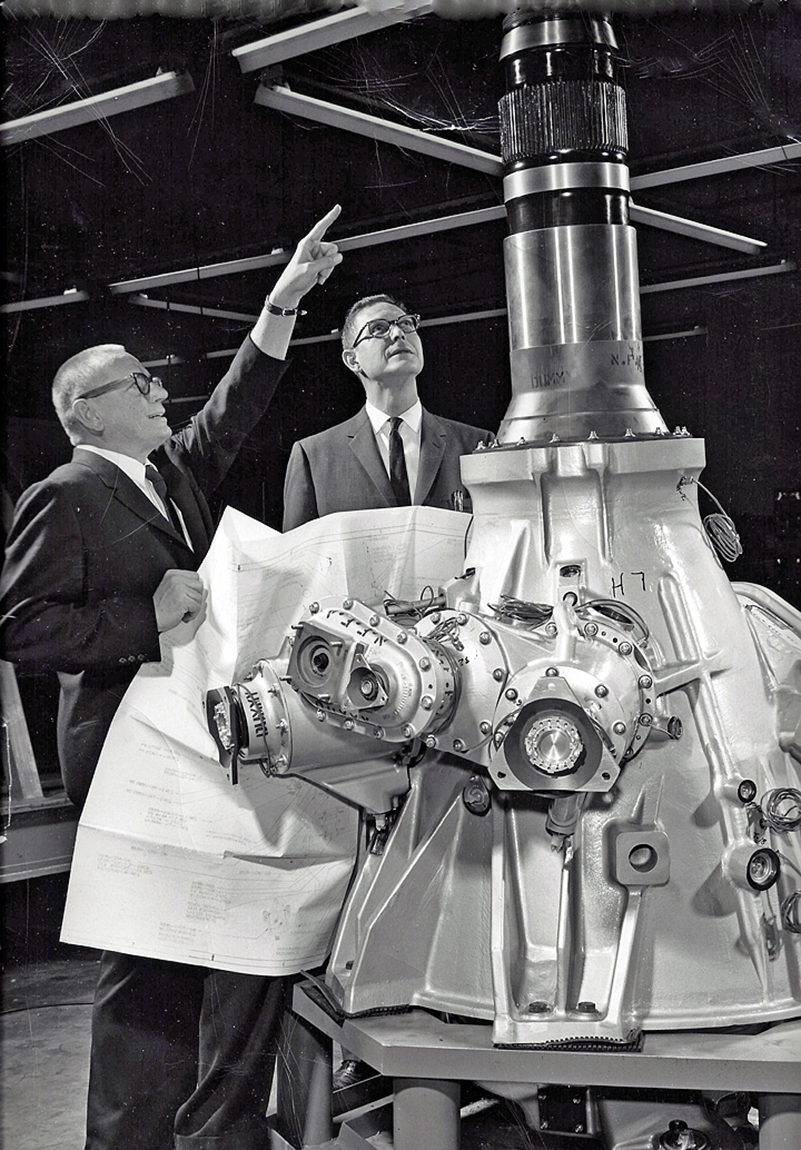
Accessory Gearbox. The accessory gearbox drives the No. 2 generator, second-stage servo hydraulic pump, winch hydraulic pump, and the accessory gearbox oil pump. The accessory gearbox is driven by the main gearbox when the main rotor is turning and the APP when the main rotor is stopped.
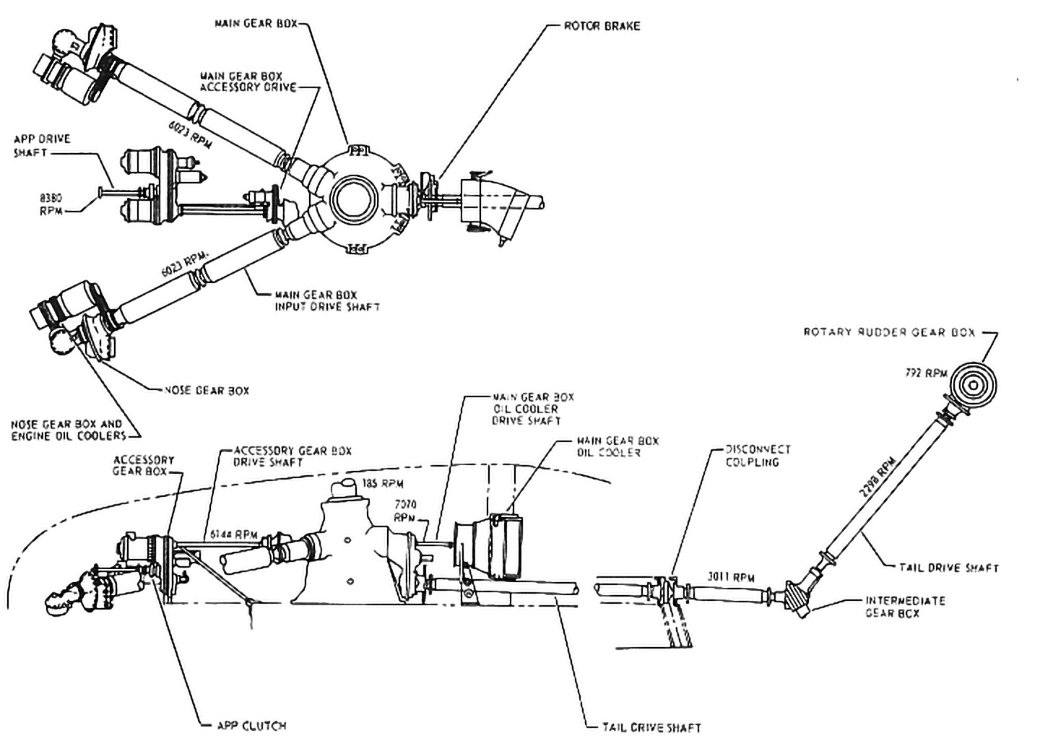
Tail Rotor Assembly. A 4 bladed 16foot diameter all metal semi-articulated tail rotor was installed. The tail rotor pitch change was accomplished by a 2 stage hydraulic servo.
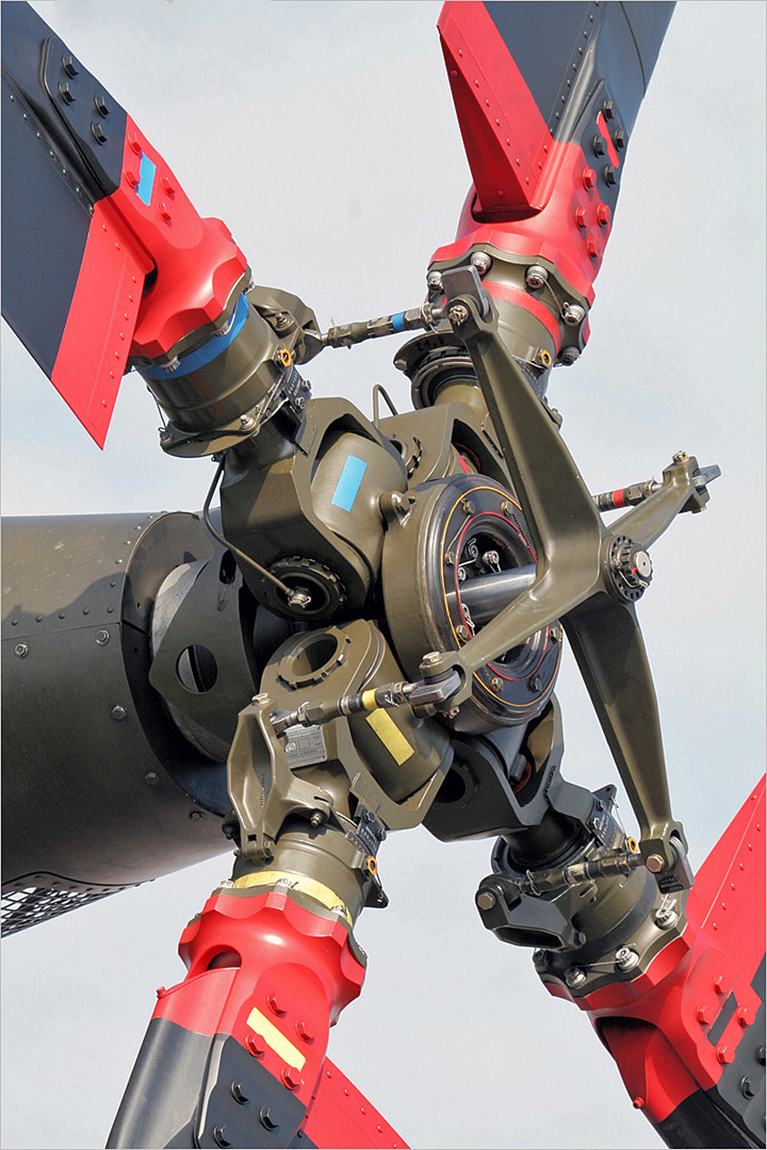
Engine. Two General Electric T-64GE-6, 2,850 shp (2,130 kw) free turbine turboshaft engines were installed on the CH-53A. More powerful models of the T-64 engines were used by various models culminating with the CH-53D using the 3,925 shp (2,927 kw) T64-GE-413 engine
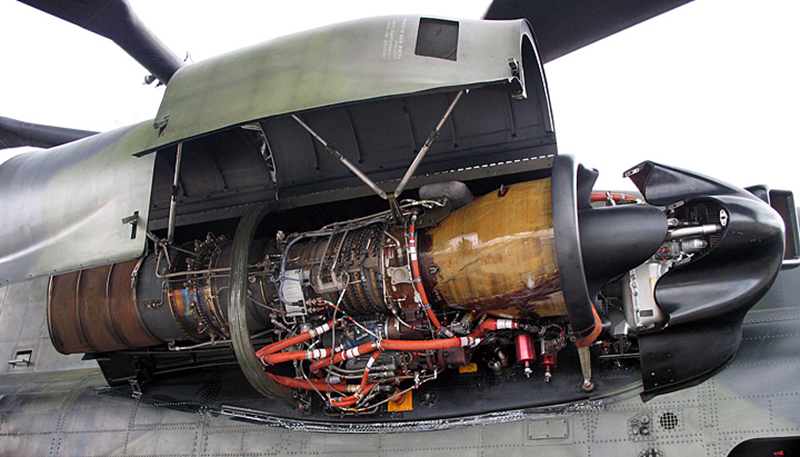
Engine Air Particle Separators (EAPS). To extend engine life in hostile environments based on experience in Vietnam, EAPS was installed on most H-53 model helicopters. The engine air particle separators were designed to remove visible moisture, sand, dust, and other foreign particles from the engine inlet air.Each EAPS unit contained 759 STRATA tubes. As the inlet air traveled through the STRATA tube it traveled in a cyclonic motion which caused foreign particles to migrate towards the walls of the tube and pass into the scavenge ducting. The clean air continued into the engine and the scavenge blowers exhausted the particle laden air overboard. The EAPS units were hinged to swing away to allow normal access to the engine inlet and servicing of the nose gearbox. Bypass doors opened in the event of EAPS clogging and at airspeeds above 60 knots. The electric power for the EAPS was provided by the power normally used for the nose gearbox fairing anti-ice controllers.
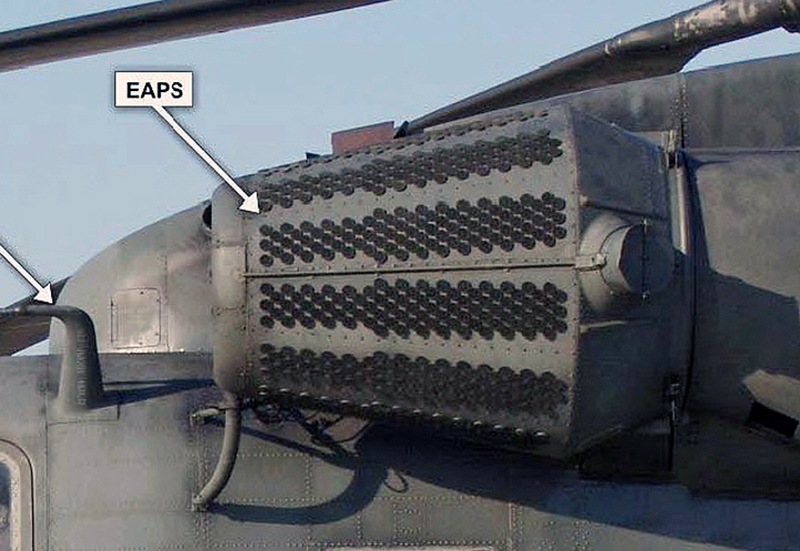
Auxiliary Power Plant (APP). The S-65 helicopters were equipped with a Solar T-62T-27 Gas Turbine APP mounted on the top forward section of theupper deck of the helicopter which powered the accessory gearbox to provide hydraulic and electrical power to the helicopter. The APP weighed 83 pounds and was rated at 100 shp. The APP turbine turned at 61,248 rpm was reduced to 8,380 rpm through a reduction gear system. The APP was started by hydraulic pressure from accumulator (s)
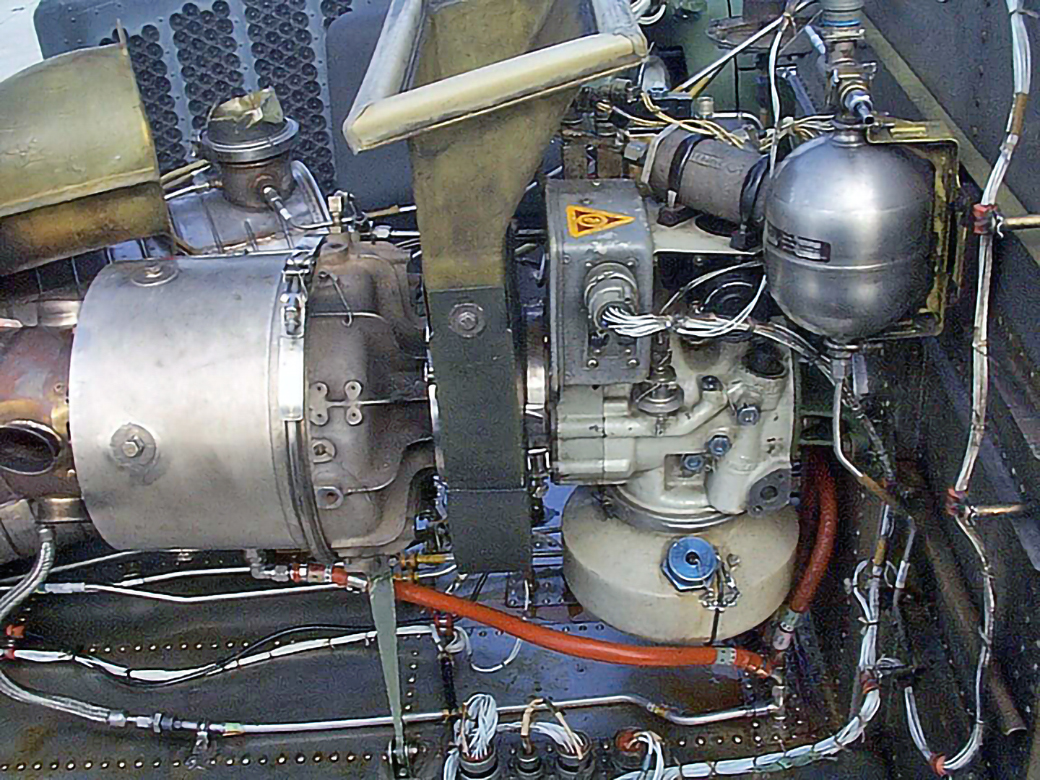
Fuel System. Main Fuel Tanks S-65 helicopters were equipped two 319 gallon main fuel tanks in sponsons attached to the cabin. Each tank consisted of a single bladder type fuel cell with the bottom third of each cell being self-sealing. No boost pumps were installed in the tanks. Fuel was sucked from tanks using a “Soda Straw” technique by boost pumps above the cabin. A crashworthy fuel system could be installed by a modification kit which included self-sealing breakaway valves where fuel lines passed through the fuel cell wall. Contamination traps were installed in the vent lines to remove sand and other contaminates.
Internal Range Extension Tanks S-65 helicopters modified with a retrofit kit could install up to seven 285 gallon tanks in the cabin. For safety, these tanks were filled with reticulated foam to prevent an explosive fuel/air mixture from forming in an empty or partially filled tank. Internal tanks contained fuel transfer pumps to transfer fuel to the main tanks. Each empty tank including tiedown chains, electrical harness, and hoses weighed 340 pounds.
External Auxiliary Fuel Tanks Jettisonable 650 gallon external tanks were installed on a pylon attached to the sponsons on CH-53D and HH-53C helicopters. Theses tanks were fabricated by winding a fiberglass-composite filament over a thin aluminum shell. For cg (center of gravity) control the tanks contained two compartments. During fueling the forward compartment filled first and then the aft compartment. Engine compressor bleed air was used to force fuel from the auxiliary fuel tanks to the main tanks.
General Arrangement Drawing

Configuration Features of S-65 Three Engine Models
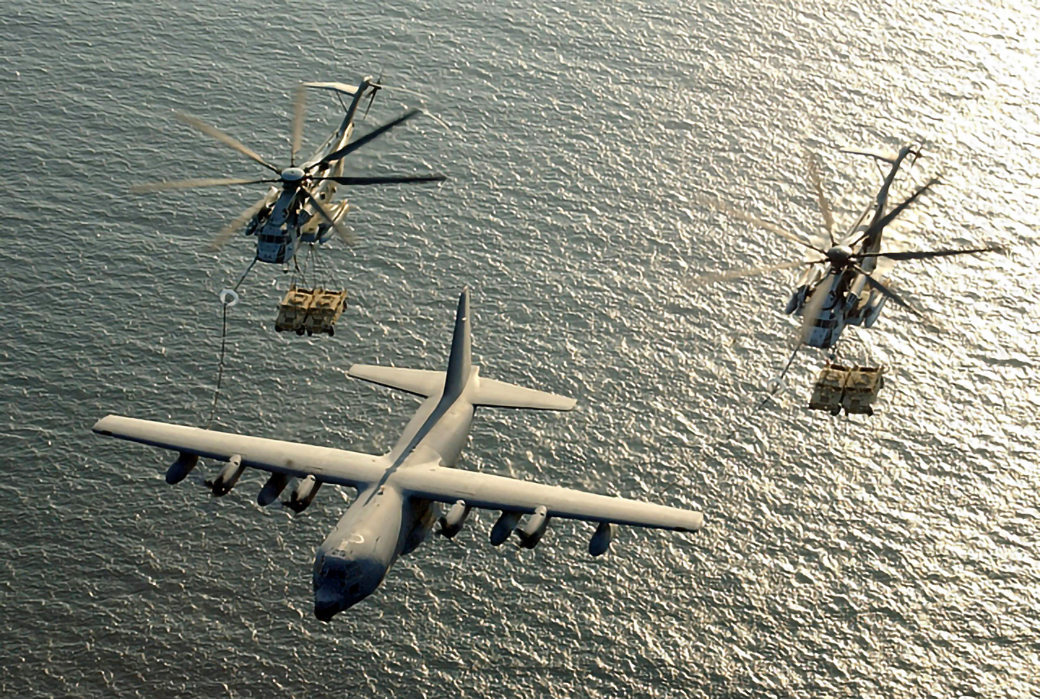
CH-53E Super Stallion
- Lifted a payload of 37,000 pounds
- Flew at a gross weight of 75,000 pounds
- Flew at a Maximum Forward Speed of 182 knots
- Exceeded a rate of climb of 6,000 feet per minute
- Demonstrated hovering at 70,000 pounds with one engine inoperative
- The design goal of doubling the lift capability of the helicopter was accomplished with only a 10% increase in size of the helicopter.
General Arrangement Drawing
General Characteristics and Performance
| Performance Standard Day at Sea Level | CH-53D | CH-53E | |||
|---|---|---|---|---|---|
| Maximum speed (Vne) CH-53D Elastomeric Head | 130 kts / 241 km/hr | 170 kts / 315 km/hr | |||
| Range with maximum payload | 540 miles / 1,000 km | 540 miles / 1,000 km | |||
| Service ceiling | 16,750ft / 5,106 m | 18,500 ft / 5,640 m | |||
| Rate of Climb | 2,460 ft/min /12.5 m/s | 2,500ft/min / 13 m/s |
| Weights | CH-53D | CH-53E |
|---|---|---|
| Maximum takeoff gross weight | 42,000 lbs / 19,050.9kg | 73,500 lbs / 33,300 kg |
| Weight empty | 26,500 lbs / 12,020.2kg | 33,226 lbs / 15,070kg |
| Maximum fuel load – Main Tanks | 638 gal / 2,415.1 ltr | 977 gal / 3,698.4ltr |
| Maximum fuel load – External Drop Tanks | 1,300gal / 4,921 ltr | 1300 gal / 4,921 ltr |
| Maximum fuel load – Cabin Range Extension Tanks (7) | 1,995 gal / 7,551.9 ltr | |
| Useful Load | 15,500lbs / 7,030.7 kg | 40,234 lbs / 18,249.8 kg |
| Maximum External Load ( Cargo Hook) | 20,000lbs / 9,071.8 kg | 32,000lbs / 14,515 kg |
| General Data | CH-53D | CH-53E |
|---|---|---|
| Crew seating capacity | 2 | 2 |
| Seating capacity | Up to 29 passengers. 47 with center seats | Up to 36 passengers. 55 with center seats |
| Powerplant Ratings Standard Day at Sea Level | |
|---|---|
| CH-53A General Electric T-64-6 | 2,850 shp / 2,130 kw |
| CH-53D General Electric T64-GE-413 | 3,925 shp / 2,927 kw |
| CH-53E General Electric T-64-GE-416 (3) | 4,380 shp / 3,270 kw |
| Aircraft Dimensions | CH-53D | CH-53E |
|---|---|---|
| Main rotor diameter (blade tip circle) | 72’ 2.7″ / 22 m | 72’ 2.7” / 22 m |
| Tail rotor diameter (blade tip circle) | 16’ / 4.9 m | 20′ / 6.1 m |
| Fuselage length | 67’ 2.4” / 20.42 m | 73’ 3.9” / 22.35 m |
| Length over-all (including rotors) | 88’ 2.4” / 26.82 m | 99’ 0.5” / 30.2 m |
| Height over-all | 17’ 2” / 5.2 m | 17’ 2” / 5.2 m |
| Main landing gear tread | 15′ 6″ / 4.7 m | 15′ 6″ / 4.7 m |
Production History
Sikorsky Aircraft S-65 production consisted of 737 helicopters.
| S-65 Customer and Model | Quantity |
|---|---|
| U.S. Marine Corps YCH-53A prototype helicopters | 2 |
| U.S Marine Corps CH-53Ahelicopters (15 modified to RH-53A minesweeping configuration). | 139 |
| U.S. Air ForceHH-53B CSAR helicopters | 18 |
| U.S. Air Force HH-53C CSAR helicopters (modified by customer to MH-53H/J/H configurations) | 40 |
| U.S. Marine Corps CH-53D | 126 |
| U.S. Navy RH-53D Minesweeping helicopters( 6 sold to Iran by U.S Government FMS) | 36 |
| S-65C-1 (CH-53G) helicopters built in a Co-Production Program for the German Army (Heersflieger) by VFW/Fokker in Speyer, Germany. CH-53G German Army helicopters were modified by customer to GA/GE/GS configurations. The first 2 CH-53G helicopters were built by Sikorsky Aircraft followed by 18 kits of structural components and 2 kits of detailed parts which were assembled in Germany. The remaining CH-53G helicopter airframes were complete German products with dynamic components provided by Sikorsky Aircraft. | 112 |
| S-65C-2 (CH-53D) Austrian Army helicopters (sold to Israel). | 2 |
| S-65C-3 Yasur (CH-53D) Israeli Air Force helicopters (modified by customer to Yasur 2000 and Yasur 2025 configurations) | 35 |
| YCH-53E Prototype helicopters | 2 |
| CH-53E U.S. Marine Corps helicopters | 178 |
| M-53E U.S. Navy Minesweeping helicopters | 63 |
| S-65 Production Total | 753 |
CH-53K
The replacement for the CH-53E is presently (2013) in development. In April, 2006 a $3.6 billion contract was awarded by the Naval Air Systems Command to design and develop the CH-53K Heavy Lift helicopter for the USMC. The contract provided for one Ground Test Vehicle (GTV) and four flight articles designated as Engineering Development Models (EDM). In addition, 2 additional GTV helicopters were built for laboratory structural testing, one static test article and one fatigue test article. The design goals for the CH-53K were to increase the lifting ability to three times the CH-53E (27,000 pounds) with a 110 mile radius under USMC hot and high conditions while maintaining the same “footprint” as the CH-53E for shipboard operations. Other design parameters are a 23% reduction in maintenance man-hours, increased survivability, and a 20% reduction in fuel consumption.
The CH-53K is powered by three GE38-1B 7,500 shp (5,600 kw) turbo shaft engines. The flight control system is a fly-by-wire system. The main gearbox features a split torque design to more evenly distribute engine power. The seven blade elastomeric folding main rotor features a reduced maintenance design. The four bladed bearingless tail rotor is a design similar to the Sikorsky H-60 series helicopters The fourth generation all composite main rotor blades have an advanced airfoil section and an anhedral tip for enhanced lift. The hybrid composite cabin structure provides lighter weight and lower vibration levels than aluminum.
On December 4, 2012 the CH-53K GTV was rolled out at the Sikorsky Florida Assembly and Flight Operations (FAFO) facility in West Palm Beach Florida and delivered to the Sikorsky flight test team.
On June 6, 2013 Sikorsky Aircraft Corp. received a $435 million U.S. Navy contract amendment to build four production-representative CH-53K heavy lift helicopters for the U.S. Marine Corps. Designated as System Demonstration Test Articles (SDTA), the four aircraft will enable the Marines to conduct operational evaluation of the new helicopter system in support of Initial Operational Capability scheduled for 2019.
Additional Information
Restored S-65 helicopters are on display at the following locations.
| Restored S-65 helicopters are on display at: | |
|---|---|
| National Museum of Naval Aviation, Pensacola, FL | CH-53A USMC BuNo 153715 |
| Combat Air Museum, Forbes Field, Topeka, KS | NCH-53A Navy BuNo 152399 |
| Air Commando Park, Hurlburt Field, Florida | MH-53M Pave Low IV, AF Serial No. 68-10928 |
| National Museum of the USAF, Wright-Patterson AFB,OH | MH-53M Pave Low IV, AF Serial No. 68-10357 |
| Hill AFB Museum, Ogden, Utah | MH-53M Pave Low IV, AF Serial No. 68-10369 |
| Museum of Aviation, Robbins AFB, GA | MH-53M Pave Low IV, AF Serial No. 70-1626 |
| Royal Air Force Museum, RAF Cosford, UK | MH-53M Pave Low IV, AF Serial No.68-8284 |
| Air Force Armament Museum next to Eglin AFB, FL | MH-53M Pave Low IV, AF Serial No.73-1652 |
| Pacific Aviation Museum, Ford Island, Oahu, HI | CH-53D USMC BuNo157173 |
| Naval Air Museum, Barbers Point, Oahu, HI | CH-53D USMC BuNo156964 |
| Air Victory Museum, Medford, NJ | RH-53D Navy BuNo 158690 |
- by Vinny Devine
Related Articles
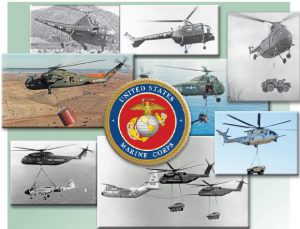
Sikorsky Builds Marine Corps Heavy Lift
The evolution of the Marine Corps’ CH-53K King Stallion heavy lift helicopter beginning with the Sikorsky S-56 in 1953.
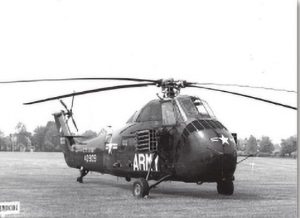
Evolution of the Armed Helicopter
Military users quickly understood the flexibility and fire-power of rotary wing platforms and ultimately evolved highly integrated weapons systems ready to protect themselves and others.

Sikorsky Helicopters in U.S. Air Force Rescue Squadrons
The HH-60W Combat Rescue Helicopter is the latest in the life-saving line of Sikorsky helicopters made for U.S. Air Force Rescue Squadrons. The Whiskey will round out a century of vertical flight rescue heroism.
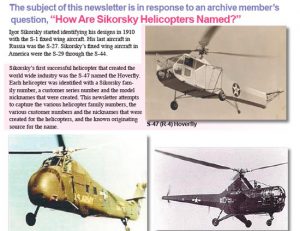
How Sikorsky Helicopters Are Named
The subject of this newsletter is in response to an archive member’s question, “How Are Sikorsky Helicopters Named?”

Sikorsky Aircraft in the 1980s
Business optimism reigned supreme at Sikorsky Aircraft during the 1980s decade.
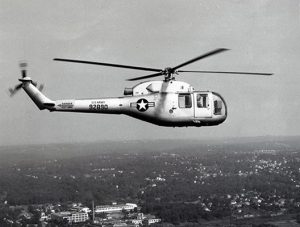
Sikorsky Aircraft in the 1960s
The decade of the 1960s gave birth to the era of Sikorsky turboshaft engine-powered helicopters.
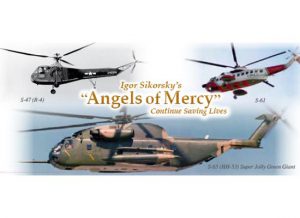
70th Anniv. of the First Helicopter Humanitarian Mission
Igor Sikorsky’s “Angels of Mercy” continue to save lives. 2014 marks the 70th anniversary of the first helicopter humanitarian mission in the world.

